Using my perfected master scone recipe, build your own scones with a variety of add-ins like chocolate chips, berries, or cheese and herbs. These better-than-the-bakery treats are flaky, flavorful, and moist with crisp crumbly edges. There’s a lot of helpful information and step-by-step photos, but feel free to jump right to the recipe!

Scones are sweet or savory, perfect with coffee and tea, welcome at baby showers, bridal showers, brunch, snack time, bake sales, Mother’s Day, and wherever muffins or coffee are appropriate. (All the time!)
But depending on the recipe and technique, scones can be dry and sandpaper-y with flavor comparable to cardboard. They can also over-spread and taste pretty boring. However, boring isn’t in our scone vocabulary!! My basic scone recipe promises uniquely crisp and buttery scones with crumbly corners and a soft, flaky interior.
I have several scone recipes that begin with the same basic formula. Let’s review the fundamentals so you can learn how to make the best scones. Sit back because there’s a lot to cover in this post!

What are Scones?
Depending where you live, the term “scone” differs. English scones are more similar to American biscuits and they’re often topped with butter, jam, or clotted cream. American scones are different, but different isn’t necessarily a bad thing! Today’s scones are sweeter, heavier, and aren’t usually topped with butter because there’s so much butter IN them. Sweetness aside, there’s still room for vanilla icing or a dusting of confectioners’ sugar on top. By the way, here’s my favorite recipe for traditional scones.
Scones are leavened with baking powder, so making them is generally quick. Blueberry scones are my favorite variety, but that quickly switches to pumpkin scones in the fall months! (Here are all my scone recipes.)
No matter which flavor you choose, these scones are:
- Moist & soft inside
- Crumbly on the edges
- Buttery & flaky
- Not sandpapery 🙂
Video Tutorial: Scones
Let’s start with a video tutorial.

Only 7 Ingredients in this Basic Scone Recipe
You only need 7-9 ingredients for my master scone recipe.
- Flour: 2 cups of all-purpose flour is my standard amount, but set extra aside for the work surface and your hands.
- Sugar: I stick with around 1/2 cup of sugar for this scone dough. Feel free to slightly decrease, but keep in mind that the scone flavor and texture will slightly change. Reduce to about 2 Tablespoons for savory flavors. Brown sugar works too. However, if using brown sugar, whisk it into the wet ingredients to get out all the lumps. For example, see my caramel apple scones.
- Baking Powder: Adds lift.
- Salt: Adds flavor.
- Butter: Besides flour, butter is the main ingredient in scones. It’s responsible for flakiness, flavor, crisp edges, and rise.
- Heavy Cream or Buttermilk: For the best tasting pastries, stick with a thick liquid such as heavy cream or buttermilk. I usually use heavy cream, but if you want a slightly tangy flavor, use buttermilk. Thinner liquids change the flavor and appearance. You’ll be headed down a one way street to dry, bland, and flat scones.
- Egg: Adds flavor, lift, and structure.
- Optional: Vanilla extract adds necessary flavor to sweet scones, but skip it if you’re making savory scones. Depending on the flavor, cinnamon is another go-to ingredient.
And don’t forget about the add-ins! Scroll down to see all my favorite scone flavors.

How to Make Scones from Scratch
So now that you understand which ingredients are best, let’s MAKE SCONES!
- Mix the dry ingredients together. Use a big mixing bowl because you want lots of room for the mixing process.
- Cut in the grated frozen butter. You can use a pastry cutter or 2 forks, like we do with pie crust, or your hands. A food processor works too, but it often overworks the scone dough. To avoid overly dense scones, work the dough as little as possible. Messy and crumbly is a good thing!
- Whisk the wet ingredients together.
- Mix wet ingredients and dry ingredients. Mix together, then pour out onto the counter.
- Form into a disc and cut into wedges. Wedges are easiest, but you can make 10-12 drop scones like I do with my banana scones.
- Brush with heavy cream or buttermilk. For a golden brown, extra crisp and crumbly exterior, brush with liquid before baking. And for extra crunch, a sprinkle of coarse sugar is always ideal!
- Refrigerate for at least 15 minutes. Keep scone dough as cold as possible. To avoid over-spreading, I recommend chilling the shaped scones for at least 15 minutes in the refrigerator before baking. In fact, you can even refrigerate overnight for a quick breakfast in the morning!
- Bake until golden brown. Scones bake in a relatively hot oven for only 20-25 minutes.

Cold Ingredients & Frozen Grated Butter
Keeping scone dough as cold as possible prevents over-spreading. When scones over-spread in the oven, they lose the flaky, moist, and deliciously crumbly texture. In other words, they’re ruined. But the easiest way to avoid disaster is to use cold ingredients like cold heavy cream, egg, and butter.
But frozen grated butter is the real key to success.
Like with pie crust, work the cold butter into the dry ingredients to create crumbs. The butter/flour crumbs melt as the scones bake, releasing steam and creating air pockets. These pockets create a flaky center while keeping the edges crumbly and crisp. Refrigerated butter might melt in the dough as you work with it, but frozen butter will hold out until the oven. And the finer the pieces of cold butter, the less the scones spread and the quicker the butter mixes into the dry ingredients. Remember, you don’t want to over-work scone dough.

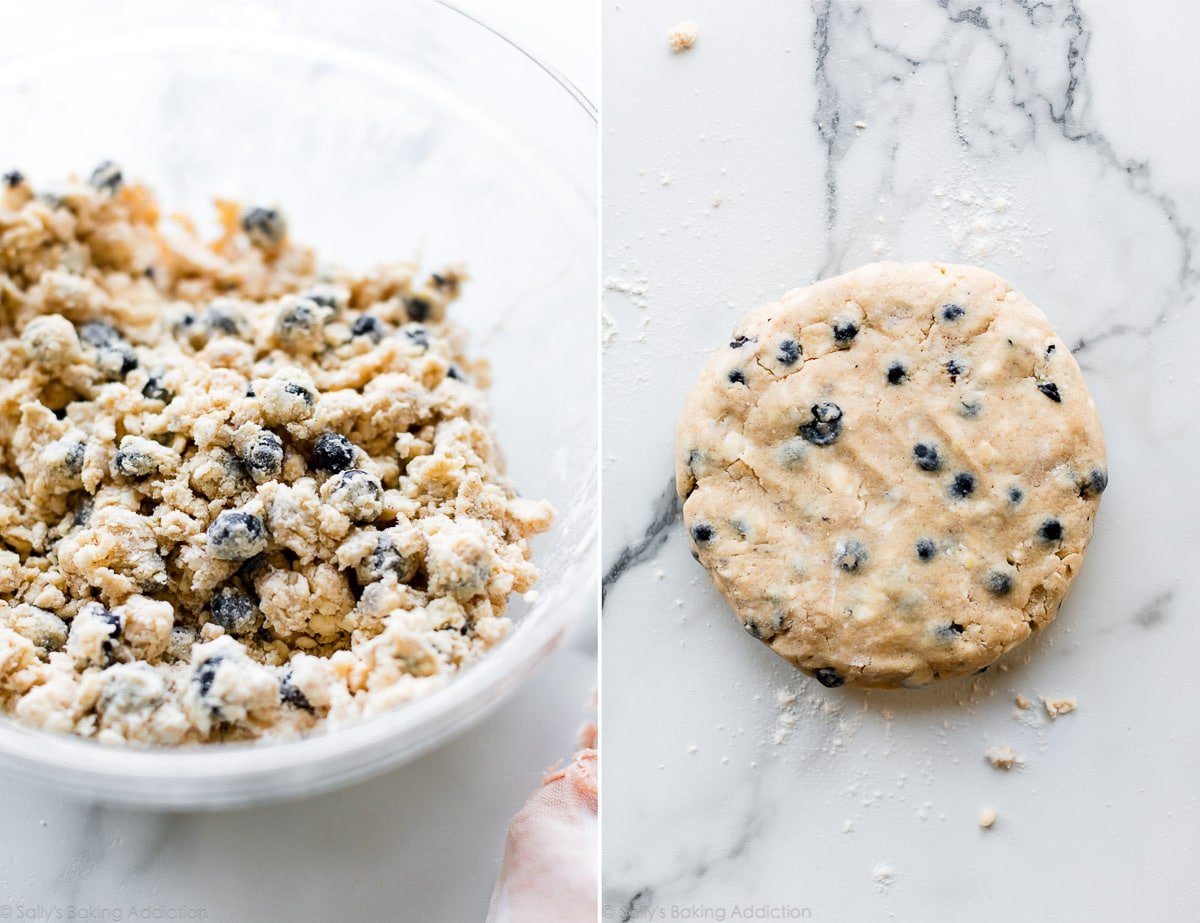

3 Tricks for Perfect Scones
If you take away anything from this post, let these be it!
- Heavy Cream or Buttermilk: Avoid thinner milks which yield a flatter, less flavorful scone. Canned coconut milk makes a wonderful nondairy option!
- Frozen Grated Butter: See above!
- Refrigerate Before Baking: Remember, cold dough is a successful dough. To avoid over-spreading, I recommend chilling the shaped scones for at least 15 minutes in the refrigerator before baking.
How to prevent flat scones: See #2 and #3. 🙂

How to Freeze Scones
I used to be totally against freezing scone dough. You see, the baking powder is initially activated once wet and if you hold off on baking, the scones won’t rise as much in the oven. However, the decrease in rise is so slight that it doesn’t make a noticeable difference. In fact, you can even shape this scone dough into wedges and refrigerate overnight before baking.
- Freeze Before Baking: Freeze scone dough wedges on a plate or baking sheet for 1 hour. Once relatively frozen, you can layer them in a freezer-friendly bag or container. Bake from frozen, adding a few minutes to the bake time in the recipe below. Or thaw overnight, then bake as directed.
- Freeze After Baking: Freeze the baked and cooled scones before topping with icing or confectioners’ sugar. I usually freeze in a freezer-friendly bag or container. To thaw, leave out on the counter for a few hours or overnight in the refrigerator. Warm in the microwave for 30 seconds or on a baking sheet in a 300°F (149°C) oven for 10 minutes.

15+ Scone Flavors
- Blueberry Scones and Chocolate Chip Scones (both pictured)
- Cranberry Orange and Pumpkin Scones
- Banana Scones and Lavender Scones
- Raspberry Almond Buttermilk Scones
- Lemon Blueberry Scones and Sprinkle Scones
- Caramel Apple and Cinnamon Chip Scones
- Triple Chocolate Scones – they taste like brownies!
- Strawberry Lemon Poppy Seed Scones
- Ham & Cheese Scones
- Mixed Berry (pictured): Follow recipe below and add fresh or frozen mixed berries. Raspberries and blackberries burst easily, so don’t go overboard on those.
- Cherry Chocolate Chip: Follow recipe below and add 3/4 cup semi-sweet chocolate chips and 3/4 cup chopped fresh or frozen cherries.
- Fresh Herb: Reduce sugar to 2 Tablespoons, leave out vanilla extract, and add 2 minced garlic cloves, 1/2 teaspoon ground black pepper, 1/2 cup chopped herbs such as rosemary, parsley, and basil. Additionally, feel free to add 1 cup shredded cheese to the dough and top with sea salt before or after baking!
Using the master recipe below as a starting point, toss in your favorite add-ins like white chocolate chips, toasted pecans, sweetened or unsweetened coconut, dried cranberries, peanut butter chips, etc. If it’s a particularly wet add-in like chopped peaches, blot them with a paper towel before adding to the dough. Top with lemon curd, raspberry sauce, or any of the suggested toppings below. Above all, have fun finding your favorite flavor!
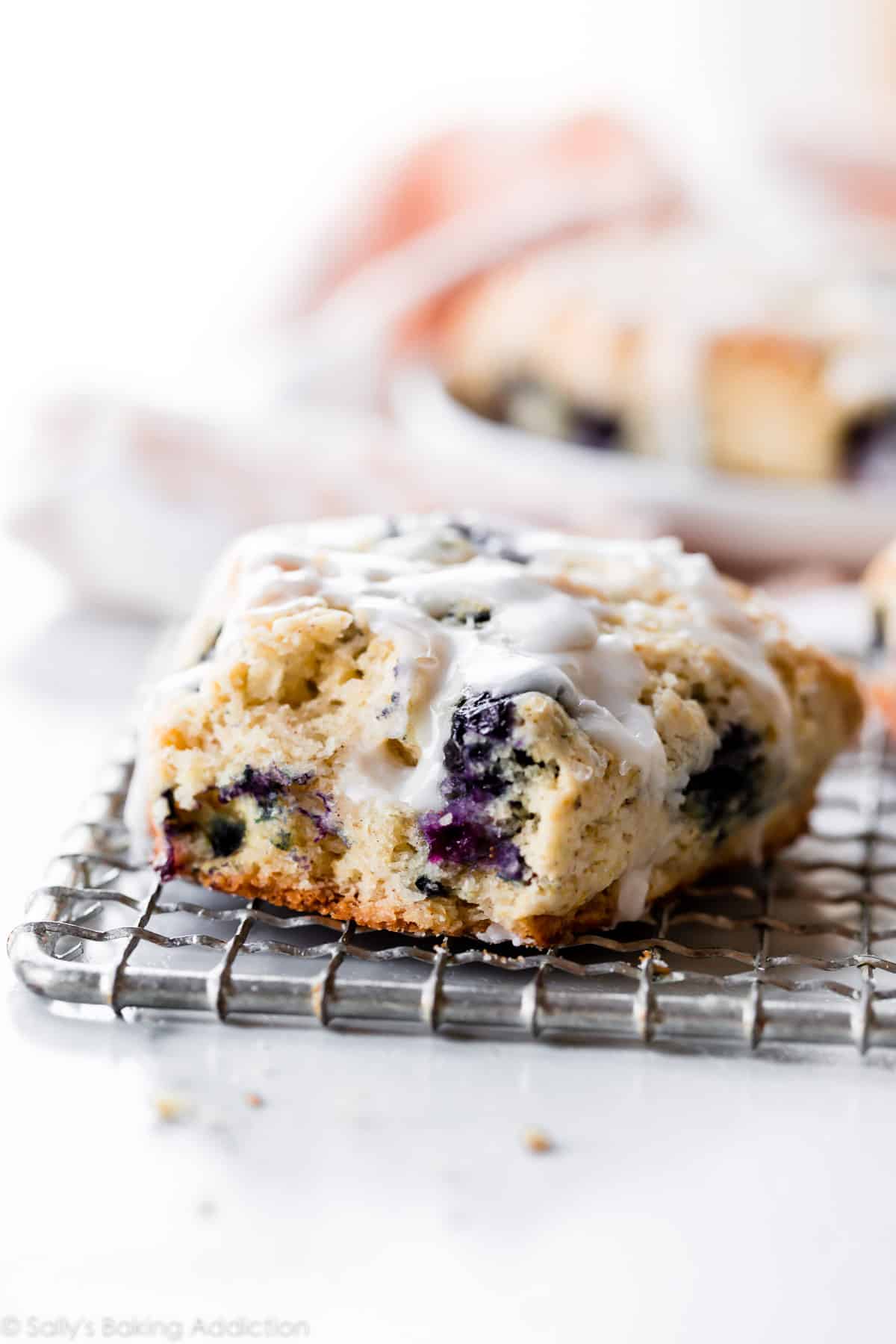
Look At All Of Your Scones!
Feel free to email or share your recipe photos with us on social media. 🙂
Print
How to Make Perfect Scones
- Prep Time: 30 minutes
- Cook Time: 25 minutes
- Total Time: 1 hour
- Yield: 8 large or 16 small scones
- Category: Breakfast
- Method: Baking
- Cuisine: American
Description
Use this basic scone dough for any sweet scone variety. See blog post for a couple savory scone options. Feel free to increase the vanilla extract and/or add other flavor extracts such as lemon extract or coconut extract. Read through the recipe before beginning. You can skip the chilling for 15 minutes prior to baking, but I highly recommend it to prevent the scones from over-spreading.
Ingredients
- 2 cups (250g) all-purpose flour (spooned & leveled), plus more for hands and work surface
- 1/2 cup (100g) granulated sugar
- 1/2 teaspoon salt
- 2 and 1/2 teaspoons baking powder
- 1/2 cup (1 stick; 115g) unsalted butter, frozen
- 1/2 cup (120ml) heavy cream or buttermilk (plus 2 Tbsp for brushing)
- 1 large egg
- 1 and 1/2 teaspoons pure vanilla extract
- 1–1.5 cups add-ins such as chocolate chips, berries, nuts, fruit, etc
- optional: coarse sugar for topping
Instructions
- Whisk flour, sugar, salt, and baking powder together in a large bowl. Grate the frozen butter using a box grater. Add it to the flour mixture and combine with a pastry cutter, two forks, or your fingers until the mixture comes together in pea-sized crumbs. See video above for a closer look at the texture. Place in the refrigerator or freezer as you mix the wet ingredients together.
- Whisk 1/2 cup heavy cream, the egg, and vanilla extract together in a small bowl. Drizzle over the flour mixture, add the add-ins, then mix together until everything appears moistened.
- To make triangle scones: Pour onto the counter and, with floured hands, work dough into a ball as best you can. Dough will be sticky. If it’s too sticky, add a little more flour. If it seems too dry, add 1-2 more Tablespoons heavy cream. Press into an 8-inch disc and, with a sharp knife or bench scraper, cut into 8 wedges. For smaller scones, press dough into two 5-inch discs and cut each into 8 wedges. To make 10-12 drop scones: Keep mixing dough in the bowl until it comes together. Drop scones, about 1/4 cup of dough each, 3 inches apart on a lined baking sheet. To make mini (petite) scones, see recipe note.
- Brush scones with remaining heavy cream and for extra crunch, sprinkle with coarse sugar. (You can do this before or after refrigerating in the next step.)
- Place scones on a plate or lined baking sheet (if your fridge has space!) and refrigerate for at least 15 minutes.
- Meanwhile, preheat oven to 400°F (204°C).
- Line a large baking sheet with parchment paper or silicone baking mat(s). If making mini or drop scones, use 2 baking sheets. After refrigerating, arrange scones 2-3 inches apart on the prepared baking sheet(s).
- Bake for 18-26 minutes or until golden brown around the edges and lightly browned on top. Larger scones take closer to 25 minutes. Remove from the oven and cool for a few minutes. Feel free to top with any of the toppings listed in the recipe Note below.
- Leftover scones keep well at room temperature for 2 days or in the refrigerator for 5 days.
Notes
- Freeze Before Baking: Freeze scone dough wedges on a plate or baking sheet for 1 hour. Once relatively frozen, you can layer them in a freezer-friendly bag or container. Bake from frozen, adding a few minutes to the bake time in the recipe below. Or thaw overnight, then bake as directed.
- Freeze After Baking: Freeze the baked and cooled scones before topping with icing or confectioners’ sugar. I usually freeze in a freezer-friendly bag or container. To thaw, leave out on the counter for a few hours or overnight in the refrigerator. Warm in the microwave for 30 seconds or on a baking sheet in a 300°F (149°C) oven for 10 minutes.
- Overnight Instructions: Prepare scones through step 4. Cover and refrigerate overnight. Continue with the recipe the following day.
- Special Tools (affiliate links): Glass Mixing Bowls | Box Grater | Pastry Cutter | Whisk | Rubber Spatula | Bench Scraper | Baking Sheet | Silicone Baking Mat or Parchment Paper | Pastry Brush
- Scone Flavors: See blog post above. If adding fruit, use fresh or frozen. If frozen, do not thaw. Peel fruits such as apples, peaches, or pears before chopping. If desired, add 1 teaspoon of cinnamon with the flour. I usually add cinnamon when making chocolate chip scones.
- Over-spreading: Start with very cold scone dough. Expect some spread, but if the scones are over-spreading as they bake, remove from the oven and press back into its triangle shape (or whatever shape) using a rubber spatula.
- Mini/Petite Scones: To make smaller scones, press dough into two 5-inch discs and cut each into 8 equal wedges. Bake for 18-20 minutes or until lightly browned.
- Optional Toppings: Vanilla icing, salted caramel, lemon icing from this iced lemon pound cake, maple icing from these banana scones, brown butter icing from these pistachio cookies, lemon curd, orange icing from these hot cross buns, raspberry icing from these mini pound cakes, dusting of confectioners’ sugar.
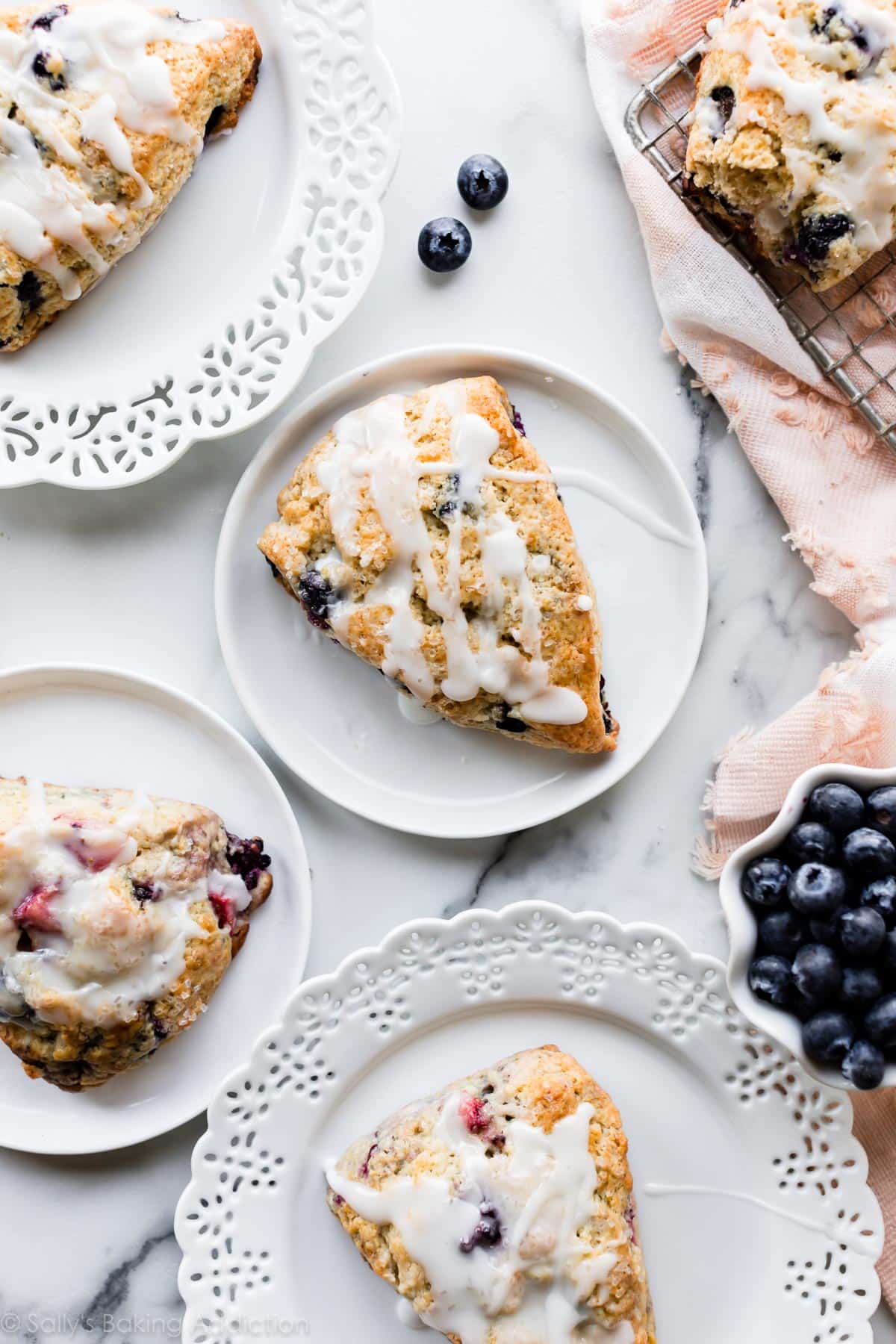


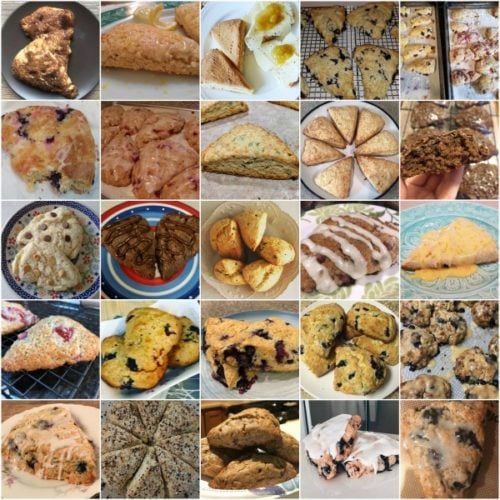

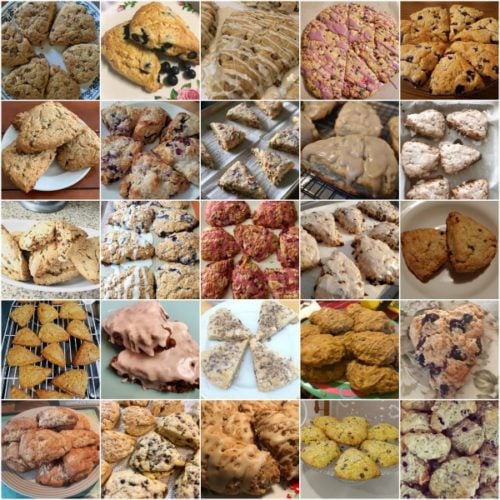










































A big hit as Valentine gifts…dried cranberries and orange zest in dough topped with orange juice, zest, powdered sugar glaze. My daughter used to make scones working in a bakery and said these were the best she ever had.
Tasty and relatively easy to make once you get to lose the fear on how to manage wet dough. Don’t panic! However, I drop 1 star because the grate-the-butter method is the worst thing ever conceived! Unless you live in the arctic, this is a mess. Frozen butter will inevitably stick to your grater, your plate, your counter, your ceiling, your hair, your walls, your floor. It will melt in your hands while you grate no matter how frozen it is. It will be hell, this was the worst part by far. I measured and lost almost 25% of the butter in the process. Instead a cleaner method is to put your butter stick inside a folded sheet of parchment paper and pound into a thin layer. Freeze this flat rectangle, then later it is easily cuttable into tiny flakes like when chopping chocolate. This will give less time for the butter to melt, is cleaner and wastes less butter as you chop into the paper itself which you use to transfer to bowl later. In fact, I chop and freeze again for a few. I live in the Caribbean and we need to deal with HOT weather, quickly! DONT GRATE YOUR BUTTER!!!!
I enjoyed this recipe! Will definitely make again!
The recipe says leave on counter for two days or refrigerate for 5 days. With meat and cheese in the scones, is it safe to consume if left not refrigerated after baking?
Hi K! Yes, they will be fine at room temperature for a couple days, but you can definitely refrigerate right away if you prefer.
I’ve used this recipe every time I’ve made scones in recent years. It’s a perfect recipe. Freezing the stick of butter ahead of time is fundamental, as are chilling the dough once the grated butter is added, as well as chilling the scones themselves for 15 minutes before putting them in the oven. Also, don’t skip the parchment paper. I used this recipe to make ginger-pecan scones today, a snow day in Southern New England, a day that just screamed for something good being baked and making the whole house smell cozy and warm. The scones turned out bakery-worthy. Wish I could post a photo!
These are wonderful! Have you tried using a food processor with the grater attachment chilled? I find it makes such a mess using a box grater and it’s hard to get to the bottom of the stick of butter grated without shredding skin!
Hello! Thanks for the nice recepie 😀 I’m going to try it this sunday. Can I prepare the dough the night before, keep it in the fridge (without freezing) and bake them in the morning to have them fresh baked for brunch?
Sure can. See the overnight instructions in the recipe notes.
These are so good I made these for my family. They were all gone in one day so I had to learn to make double batches. I am now starting to experiment with different flavors added into it I did blueberry lemon next I’m gonna try and almond cherry I am looking forward to it in my family are all excited.
This recipe looks perfect for my baby tea shower……Can you really make them ahead, bake them and pull them our to thaw in the morning? Will they be fresh ?
Hi Mary! Yes, we freeze scones all the time.
Loved this recipie. Today I used it and made cranberry orange scones, ham & cheese scones, almond cherry scones, cherry & chocolate chip scones. Tomorrow I’m gonna try bacon jalapeño cheese scones, pepperoni & cheese scones, lemon poppyseed scones, double chocolate scones. Love this basic mix for scones. The combinations of flavors are endless.
These were lovely and light and fluffy. I did add about 1/4 oats and subbed the cream for buttermilk. And added orange rind and frozen whole cranberries. Love the grating of the frozen butter technique. I will be using that every time I make scones from now on.
I love the scone recipe and how versatile it is, but mine have a pretty strong baking powder taste. Any suggestions?
Hi Lea! This can happen when baking powder is expired.
I’m an off Baker but I’ve tried several different scone recipes and keep coming back to your orange cranberry scone recipe. The others I have trouble getting them moist enough. Thanks!
Nice recipe. Definitely want to make 16 small scones (in lieu of 8 really huge ones). I found them to be more like cakes than scones. My dough wasn’t quite what I wanted but it was a very good outcome nonetheless. Congratulations to Sally for yet another great recipe addition.
I made this recipe using dried strawberries and we loved it! I think cutting the dried fruit down to just one cup would make a really nice scone, dried fruit can be over powering. I can’t wait to make them again.
My first attempt at scones and I’m quite pleased thanks to YOU Sally! Being a scientist, I tend to follow recipes precisely, possibly to a fault at times, so I appreciate your tips and notes. While shaping the dough I had a feeling it was a bit too wet, likely due to moisture from the frozen raspberries I added (I did go off-script with those). This contributed to more spread than I expected. Looking back, I should have added more flour and, as you suggest, “reshaping” mid-bake. However, the flavor and texture are both wonderful. I have made some notes for the next batch. Cheers!
I am prepping an afternoon tea for my son’s birthday this week. Including apricot white chocolate scones. Love the versatility of your recipe, but this will be my first time trying your version. Here is my *strange* question: My scones always come out fluffy, but I really love the bakery scones that are dense and chunky. How do I make that happen? Thanks!
Hi Kathy, let us know if you give our recipe a try, we would love to hear what you think!
I made this recipe twice the same morning: one with chocolate chips and a simple powdered sugar glaze, another with blueberries and a lemon glaze. My family loved them! I will definitely keep this recipe for future experimenting. Thank you for sharing!
Also, due to the snowstorm outside, I did not run out to purchase heavy cream. I just used whole milk and they turned out well. They might be better with cream, but for my family whole milk was just fine.
Thanks Fern – Whole milk is what i have on hand so i was searching for someone who baked the scones with milk. Thanks for letting us all know! trying the recipe tomorrow
I’ve made this recipe twice this week, once with chocolate chips, and once with dried cranberries and orange. Both were outstanding, made with whole wheat pastry flour and yogurt instead of buttermilk. This one is a definite keeper.
Been making this recipe for awhile now. It is my “go to” for dessert. So easy and VERY yummy!
Super excited to make this as ive always been intimidated by scones. Can almond milk be used for all ingredients asking for milk?
Hi Shellby, we recommend avoiding thinner milks which yield a flatter, less flavorful scone. Canned coconut milk makes a wonderful nondairy option!
Country crock makes a plant cream that tastes and behaves just like heavy cream!
I don’t know why I waited so long to make homemade blueberry scones. This recipe is perfect!
With 1/2 cup sugar the scones are very sweet – like a desert biscuit. I suggest that the savory versions should the main version.
This recipe is easy to follow, easy to make and easy to eat. The basic scone recipe is a wonderful primer that provides the perfect blank canvas for personalization. The scones were soft and flavorful. I added raisins and lemon zest to mine. But I know that I can make many different versions and always enjoy each one. Thanks for a well written and easy scone recipe.
These scones are the best. I stored them in a plastic container and the next morning they lost their crispness on the outside. How do I keep them crispy?
Hi Charlene, we’re so glad you love these scones! We store ours at room temperature overnight as well. You may wish to warm them up in the oven the next morning!
Can’t wait to try them
These scones are fabulous! I’ve made them 3 Saturday’s in a row now!
So delicious! Sally’s recipes unfailingly dependable
Hey Sally, I made your lemon blueberry scones for Christmas morning breakfast, and they were amazing! I’ve now been asked to make a salted maple scone. I saw your maple glaze recipe and was planning to just make a basic scone and top it with that. But, if I wanted to add maple syrup to the batter, how would I go about doing that? Adding the extra wet ingredients would throw off the mixture I’m sure. Appreciate any help! Thanks 🙂
Hi Joanna, we’re so glad you enjoyed the lemon blueberry scones! We haven’t tested a maple scone, but you can certainly try some adjustments. We would slightly reduce the cream to make up for the moisture in the maple syrup. If the dough is too sticky to shape you may have to add a bit more flour. A bit of maple extract would help amplify the maple flavor, too. Let us know if you give anything a try!
This is the only recipe I use.
so I have just started to bake lol ( 55 ) we love scones and so I decided to start, first round I baked them to long only to find out that our stove runs hotter than most, second batch I baked the strawberry, lemon, poppy seed recipe and what a hit, my wife was like keep this up. Nailed it. planning my next batches now and learning a lot from Sally. love this site, so helpful.